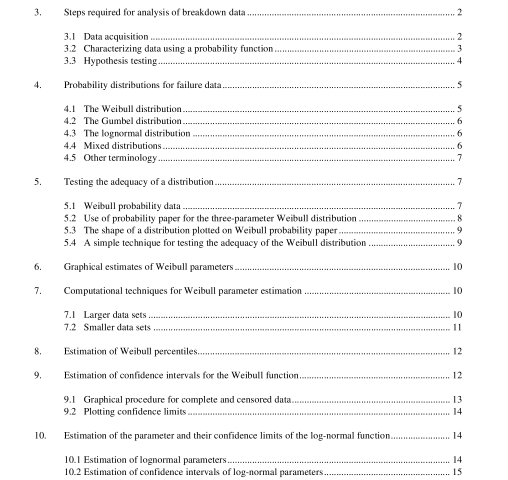IEEE 930-2004 pdf download.IEEE Guide for the Statistical Analysis of Electrical Insulation Breakdown Data
3. Steps required for analysis of breakdown data
3.1 Data acquisition
3.1.1 Commonly used testing techniques
There are two commonly used breakdown tests for electrical insulation: constant stress tests and p rogressive stress tests. In these tests a number of identical specimens are subjected to identical test regimes intended to cause electrical breakdown. In constant stress tests the same voltage is applied to each specimen (they are often tested in parallel) and the times to breakdown are measured. The times to breakdown may be widely distributed with the longest time often being more than two orders of magnitude that of the shortest. In pro- gressive stress tests an increasing voltage is applied to each specimen, usually breakdown voltages are measured. The voltage may be increased continuously with time or in small steps. Other protocols, for example impulse testing, may also be used. Breakdown voltages may be much less widely distributed with the highest voltage sometimes only being 2% more than the lowest voltage.
Various international standards, e.g., BS 2918-2 and IEC 60243, give appropriate experimental procedures for constant and progressive stress tests. This guide is intended to provide a more rigorous treatment for the breakdown data obtained in this way.
3.1.2 Other data
Breakdown data may also be available from other sources; for example, times to breakdown of the insulation in service may be available. Such data is generally much more difficult to analyze since the history of each failed insulator may not be the same (see 3.1.4), particularly as units that failed will have been replaced. It may also be unclear how many such insulation systems are in service and hence what proportion of them have failed. The techniques described in this guide are, nevertheless, appropriate for such data provided suf- ficient care is exercised in their application.
3.1.3 Data requirements
The number of data points required depends upon the number of parameters that describes the distribution and the confidence demanded in the results. If possible, failure data on at least ten specimens should be obtained; serious errors may result with less than five specimens (see also 3.2.2). If all the specimens break down, the data is referred to as complete.
In some cases, not all the specimens break down, the data is then referred to as censored. Censored data may be encountered in constant stress tests where the data are analyzed or the test is terminated before all the specimens break down. Censored data can also occur with progressive stress tests where the power supply has insufficient voltage capability to break down all the samples. In these cases, the data associated with a single group of specimens, those with the highest strength, are not known and the data set is said to be singly censored. Data may also be progressively censored. In this case, specimens may be withdrawn (or their data discounted) at any time or voltage; such data are often referred to as “suspended.” This may be the case where specimen breakdown is due to a spurious mechanism such as termination failure or flashover or where the specimen is deliberately withdrawn for alternative analysis. Censoring can occur by plan or by accident in many insulation tests and it is essential that this is taken into account in the data analysis. Less confidence can be placed in the analysis of a censored data set than in a complete set of data with the same number of specimens. If possible censored data sets should include at least ten (non-censored) data points and at least 30% of the specimens should have broken down.
3.1.4 Practical precautions in data capture
Specimens should, as far as possible, be identical, have the same history prior to testing, and be tested under the same conditions. In measuring the breakdown characteristics of materials it should be noted that the breakdown field (kilovolt per millimeter) 5 is usually dependent upon the rate of voltage rise, specimen thickness, electrode material, configuration and method of attachment, temperature, area, and frequency if an alternating voltage is applied. Other factors such as humidity and specimen age may also be important. With insulating systems such as cables and bushings, surface and interfacial partial discharges must be minimized and stress enhancements due to protrusions, contaminants and voids are likely to reduce breakdown strengths considerably.
The scope of this guide is limited to ac voltage testing, but the techniques may be applied to other failure tests (such as impulse or dc testing) with care. Knowledge of the failure mechanism may be required in order to establish the appropriate parameters to be measured. In pulse energized dc systems, for example, it may be more appropriate to measure the number of pulses to breakdown than the dc time to failure. Precautions in data capture are described more fully elsewhere, e.g., Abernethy [B1].IEEE 930 pdf download.IEEE 930-2004 pdf download
IEEE 930-2004 pdf download

Leave a Reply